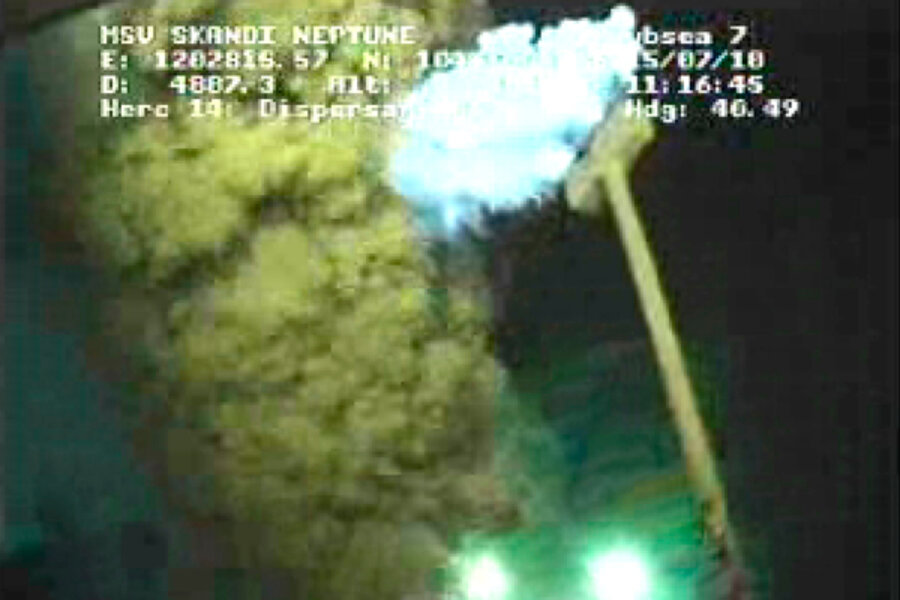BP didn't make Gulf oil spill worse with dispersants, EPA finds
Loading...
BP did not make things worse by using massive quantities of dispersant to combat the Gulf oil spill, according to research released Monday by the US Environmental Protection Agency.
Critics have worried that BP used unprecedented amounts – about 1.8 million gallons – of the chemical dispersant Corexit 9500 A, which is itself toxic. Rep. Edward Markey (D) of Massachusetts said Saturday that BP's efforts created a "toxic stew of chemicals."
But two rounds of tests conducted by the EPA suggest that Corexit is not more toxic than oil itself – either alone or when mixed with oil. Moreover, the EPA report says that Corexit is not more or less toxic than eight other alternative oil dispersants that were also tested.
The results partially vindicate BP, which refused a May 22 EPA order to find a less-toxic alternative to Corexit. The company had argued that Corexit was the least toxic chemical available – an argument that the EPA eventually accepted and which now has been validated.
But the report released Monday also vindicates the EPA's broader position that widespread use of dispersants – while not desirable – ultimately made sense under the extreme circumstances of the Gulf oil spill.
"It shows us that [using the dispersant was] a wise decision, and that the oil itself is the hazard we're concerned about and, as we've said before, is enemy No. 1," Paul Anastas, the EPA's assistant administrator for research and development, told reporters in a teleconference.
Two rounds of tests
In an initial round of tests, the EPA determined that Corexit and seven other dispersants were, by themselves, less toxic to the environment than oil alone.
Then, the EPA did a second round of toxicity testing on baby mysid shrimp and the inland silverside, a small Gulf fish. It found that the oil dispersant, when mixed with oil, was no more toxic than oil alone.
All eight oil dispersants also showed a similar level of toxicity when mixed with sweet crude oil. The mixtures were "roughly equal in toxicity to one another, but generally less toxic than oil."
Even so, he reiterated that the test results should not be construed as a blanket endorsement for slathering dispersant on future spills. Environmental conditions at the time were important variables, he said.
Along those lines, Dr. Anastas noted that toxicity tests were not conducted at the same pressures and temperatures where much of the dispersant was applied – 5,000 feet beneath the surface at the wellhead. That leaves uncertainties about how the dispersant might affect the ecosystem at that depth.
The dispersant was not showing up in subsea "clouds" of dispersed oil in the deep ocean, however, he added. And there also has been no evidence so far of the bioaccumulation of dispersant chemicals migrating up the food chain from plankton to small fish to larger creatures that could be eaten by humans, Anastas said.
A 'vast uncontrolled chemical experiment'
Meanwhile, the EPA has been testing water samples for other potential problems, such as signs of oxygen in the water becoming depleted as the oil is digested by microbes. So far, it has not found worrisome impacts – though those short-term ecosystem impacts so far are hardly definitive.
New suggestions that the oil spill might not have been as damaging as originally thought don't change the need for long-term evaluation of the effects of dispersants on deep ocean ecosystems, say environmentalists. The Gulf oil spill remains a "vast uncontrolled chemical experiment," say experts at the Environmental Defense Fund.
"This is not at all bad news today," says Richard Denison, a senior scientist with the EDF in Washington. "It will take some time for us to find out whether nature's own forces have been able to deal with much larger amount of oil than we thought possible – or whether there are going to be large effects from dispersed oil that are hard to see right now, but which may be with us for some time – effects less physical but just as profound."
Related:





